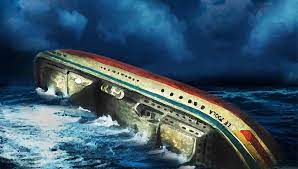On September 26, 2002, the ship Le Joola sank off the coast of The Gambia, taking with it 1,863 people officially and more than 2,000 according to the associations set up by the victims’ families.
By Ibrahima Dione
Not since the beginning of the 20th century has a civil and merchant marine accident caused so many deaths.
The sinking of the Joola was more catastrophic than that of the Titanic (1,550 deaths) in Canada in 1912.
September 26, 2002 is a black day engraved in the collective memory of the Senegalese people.
Sitting on a bench, in front of the gate of a building under construction in Mermoz, a swanky district of Dakar, Mohamed Goudiaby goes back in time.
“I heard the news on Walfadjiri Radio. Just before the announcement of the tragedy, a generic that you only hear in some cases was aired. I told myself that something had happened. The shock was enormous, the pain indescribable. I was really down. I lost four members of my family in the sinking of the Joola. It was my mother who called me to confirm their presence on the boat,” said the 17-year-old at the time.
Mohamed, dressed in a brightly colored work outfit, is from Tendouck, a district of the department of Bignona, in the region of Ziguinchor (South).
The German-made boat Le Joola entered service in 1995 to link this part of Senegal, which is difficult to access by road, to the capital Dakar.
“Many of our neighbors in Tendouck were bereaved. It’s easy to tell now. But at the time, it was very complicated emotionally. I only traveled once on the Joola. It was at least seven years before the accident happened. I have often preferred to travel by road,” says the thirty-year-old in a calibrated tone.
A little further on, Bouba Traore stands on the sidewalk of the Ouakam road.
Now 48 years old, this stocky man remembers the tragedy: “I was working at Hann Marinas. Around the stroke of 9 am, our boss came to tell us the bad news. It was very painful. I know a lady who did not get on the boat on the day of the sinking because the ship was already full to the brim.
The ferry, 76.5 meters long and 12.5 meters wide, was designed to carry a maximum of 580 people.
On the day of the tragedy, the logbook indicates that 809 tickets were sold.
In addition, there were those who do not pay: children under five years old as well as military personnel and their families.
The management of the ship is entrusted to the army.
As a result, the ship, whose last technical inspection was in 1991, had on board, at least 1,928 people of 12 nationalities.
This was three times its maximum capacity. The Joola overturned around 11 pm in a stormy sea.
Rescue services did not arrive until 18 hours later.
Only a few survivors
Under these circumstances, only 64 passengers survived the disaster and 608 bodies were recovered.
“It is too hard, but it was God’s will. Their fate was to die together at sea,” philosophizes the watchman Amadou Diacko, born in 1961.
Marie Charlotte Desiree Ngo Mbé, 31, is one of the 1,863 official victims.
This Cameroonian nun “had come to Senegal for the first time in her life. She was ordained here. She had chosen my mother as her godmother. She was very involved in the life of ‘Saint Antoine de Padoue’ Cathedral in Ziguinchor. They met there. Marie Charlotte became a big sister to us,” explains Ludovic Badiane.
Despite his young age at the time, this Mankagne (an ethnic group present in southern Senegal) remains subdued by grief.
“When I woke up the day of the tragedy, I saw my mother crying her eyes out. I had never seen her like that before. She knew that Charlotte was on the boat. A few days before this fatal trip, the nun came to our house to say goodbye. She was going to Cameroon to pick up her belongings before returning to Senegal to live out her faith,” Badiane says.
Two decades after its sinking, the Joola has not been retrieved.
The bones of a thousand victims still lie in the deep ocean, making it impossible for some grieving families to mourn properly and experience closure.
In Senegal, the courts closed the case in 2003.
Issa Diarra, the captain who died with his passengers, was designated as the sole person responsible for the accident.
In France, the dismissal of a similar case was made in 2018.
A memorial-museum is taking shape in Ziguinchor to fight against forgeting this tragedy.
Beyond the recollection, Senegal needs more to face its defects.
“We owe it to ourselves to do an introspection and to admit that the vices that are at the root of this catastrophe are rooted in our habits of taking things casually, lack of seriousness, irresponsibility, and sometimes greed,” said then president Abdoulaye Wade in a televised address on October 2, 2002.
Have we really learned from our past mistakes? Nothing is less certain today.
“We must come to our senses and people must be more disciplined. All citizens are responsible for their actions, but the authorities must also set a good example and ensure that order is maintained in society. In this country, security measures must be respected. I do not think that Senegal has really learned the lessons of the sinking of the Joola. To be convinced of this, you just have to observe what happens on a daily basis in public transport,” Mohamed Goudiaby coldly observes.
ID/cgd/fss/as/APA


